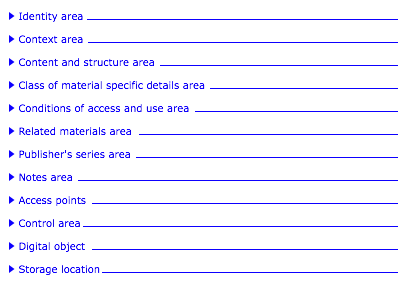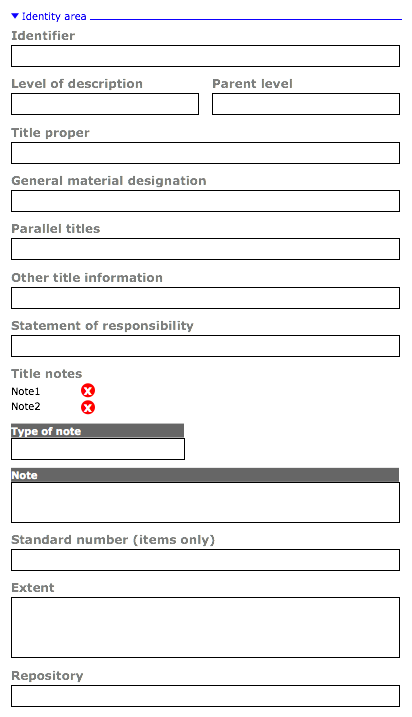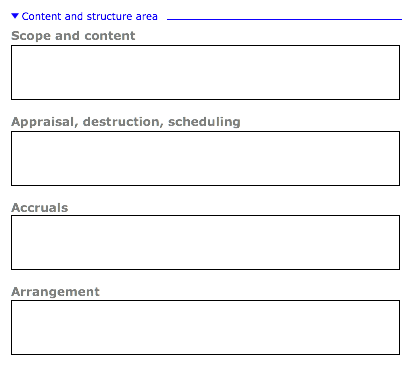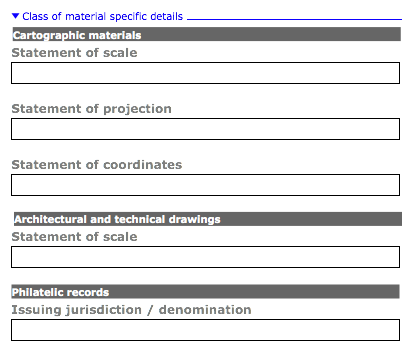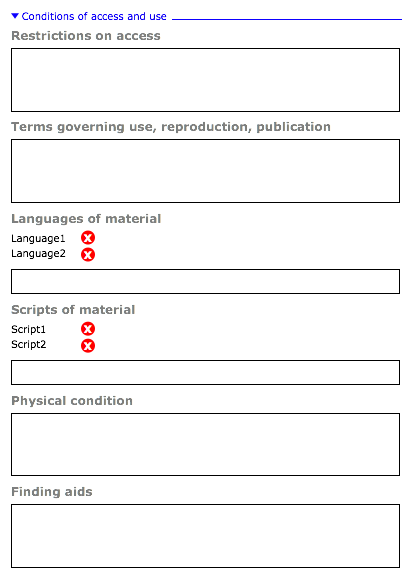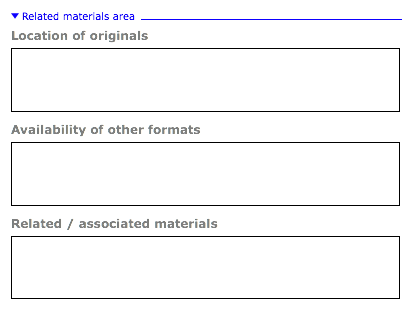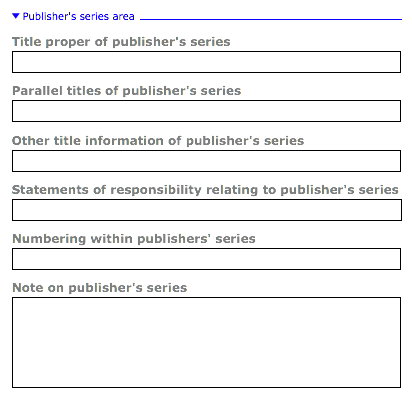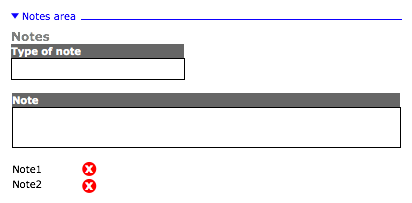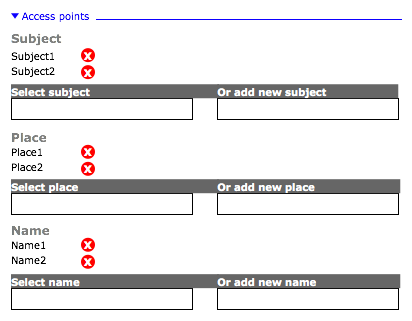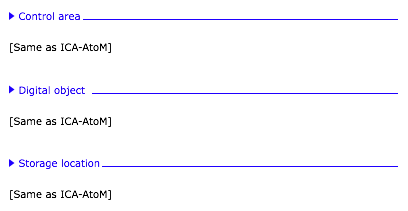BCAUL Pilot project: RAD template by ISAD(G) Areas
Main Page > Development > Development/Projects > Development/Projects/BCAUL Pilot > Development/Projects/BCAUL Pilot/Templates > RAD-in-ISAD
Contents
Overview
The purpose of this template is to provide an interface for archival description that uses the elements and field labels of the Canadian Rules for Archival Description (RAD), but organizes them according to the areas of description in ISAD(G).
The main motivations are:
(1) RAD includes several areas of description and many elements that are only marginally relevant to typical aggregate-level description. E.g. 3 of RAD's nine areas (1.2, 1.6, 1.9) are applicable only at the item level. Another area (1.3) applies only to specific media (cartographic records, architectural and technical drawings, philatelic records). A number of elements in the date and title areas (1.4 and 1.1) relate only to the description of published items. In terms of interface, this is a lot of real estate to give to elements not frequently used. On the other hand, a single area (1.8, Notes) includes a large number of elements that are commonly employed. The ISAD(G) organization distribute elements more evenly.
(2) ISAD(G) includes 2 elements (3.3.2 Appraisal, destruction, and scheduling information and 3.5.4 Publication note) that have no RAD-equivalents. An ISAD(G)-based organization gives those Canadian archivists who so wish an opportunity to incorporate these into their descriptive practices.
(3) An ISAD(G)-based template for RAD promotes harmonization of Canadian and international descriptive standards.
This implementation follows the basic outline of ISAD(G), but it does accommodate all RAD elements. Two RAD areas of description that have no ISAD(G) analogs are included in full. Two divs for Qubit-required fields that neither ISAD(G) nor RAD eviquivalents are also included.
Divs based on ISAD(G) areas:
- Identity area
- Context area
- Content and structure area
- Conditions of access and use area
- Related materials area
- Notes area
- Access points
RAD-specific divs:
Additional Qubit-required divs:
Identity area
This div corresponds to ISAD(G) area 3.1.
Qubit-required fields with no RAD equivalents:
- Identifier
- Level of arrangement
- Parent level
- Repository
RAD fields that map to ISAD(G):
- Title (RAD 1.1B / ISAD(G) 3.1.2)
- Extent (RAD 1.5B / ISAD(G) 3.1.5)
Unique RAD fields handled by Qubit properties:
- General material designation (RAD 1.1C)
- Parallel titles (RAD 1.1D)
- Other title information (RAD 1.1E)
- Statements of responsibility (RAD 1.1F)
- Standard number (RAD 1.9B)
This div follows the Qubit ISAD(G) template by including a section to add title notes.
Value lists
The following fields have drop-down value lists:
- Level of description (get values from "Levels of description" taxonomy).
- Parent level (get names of all highest-level descriptions in the system).
- General material designation (get values from "RAD GMD" taxonomy).
- Type of note (get values from "RAD title notes" taxonomy).
- Repository (get names of all records in repository table).
Context area
This div corresponds to ISAD(G) area 3.2. Qubit uses events linking actors to bodies of material -- both to associate creators with archival materials and to implements date ranges. This template follows Qubit's ISAD(G) template, substituting RAD labels.
The purpose of the Type of creation field is to:
- Specify the type of creator-relation / creation event.
- Distinguish between e.g. dates of creation and dates of accumulation.
Other RAD fields included in this div have ISAD(G) analogs:
- Custodial history (RAD 1.7C / ISAD 3.2.3).
- Immediate source of acquisition (RAD 1.8B12 / ISAD 3.2.4).
Note that the Administrative history / biographical sketch field actually resides in the creator's authority record.
- To edit, the user must click the pencil icon to be routed to the authority record for editing.
Value lists
The following fields have drop-down value lists:
- Type of creation (get values from "Event types" taxonomy).
Content and structure area
This div corresponds to ISAD(G) area 3.3.
RAD elements that map to ISAD(G):
- Scope and content (RAD 1.7D / ISAD 3.3.1)
- Accruals (RAD 1.8B19 / ISAD 3.3.3)
- Arrangement (RAD 1.8B13 / 3.3.4)
The div also includes an ISAD(G) element that has no RAD equivalent, but which Canadian archivist may wish to incorporate into their descriptive practices.
- Appraisal, scheduling, destruction (ISAD 3.3.2)
Class of material specific details area
This div has no analog in ISAD(G). It represents RAD area 1.3, which covers elements used only with specific classes of material.
RAD elements with no ISAD(G) equivalents mapped to Qubit properties (records in the property table):
- Cartographic materials -- statement of scale (RAD 5.3B)
- Cartographic materials -- statement of projection (RAD 5.3C)
- Cartographic materials -- statement of coordinates (RAD 5.3D)
- Architectural and technical drawings -- statement of scale (RAD 6.3B)
- Philatelic records -- denomination / jurisdiction (combining RAD 12.3B and 12.3C)
Conditions of access and use area
This div corresponds to ISAD(G) area 3.4.
RAD elements that have ISAD(G) analogs:
- Restrictions on access (RAD 1.8B16a / ISAD 3.4.1).
- Restrictions on use, reproduction, publication (combines RAD 1.8B16b, c, d / ISAD 3.4.2).
- Language and Script (RAD 1.B14 / ISAD 3.4.3).
- Physical condition (RAD 1.8B9a / ISAD 3.4.4).
- Finding aids (RAD 1.8B17 / ISAD 3.4.5).
Value lists
The following fields include drop-down value lists:
- Languages of material (get values from Symfony framework).
- Scripts of material (get values from Symfony framework).
Related materials area
This div corresponds to ISAD(G) area 3.5, Allied materials area. Since the term "allied materials" is not widely used in the Canadian archival community, "related materials" has been substituted.
RAD elements mapped to ISAD(G):
- Location of originals (1.8B15a / ISAD 3.5.1).
- Availability of other formats (1.8B15b / ISAD 3.5.2).
- Related / associated materials (combines RAD 1.8B18 and 1.8B20 / ISAD 3.5.3).
Note that Qubit cannot currently support the RAD distinctions between associated materials (1.8B18 - records held in different repository), related materials in different fonds (1.8B20), and related materials within the same fonds (1.8B20a).
Publisher's series area
This div has no analog in ISAD(G). It represents RAD 1.6, which applies only at the item level for information relating to the publisher's or artist's series to which an item belongs.
RAD elements that have no ISAD(G) equivalents and mapped to Qubit properties (records in the property table):
- Title proper of publisher's series (RAD 1.6B)
- Parallel titles of publisher's series (RAD 1.6C)
- Other title information of publisher's series (RAD 1.6D)
- Statement of responsibility relating to publisher's series (RAD 1.6E)
- Numbering with publisher's series (RAD 1.6F).
This div also includes a field for entering the RAD note (1.8B10) relating to publisher's series.
Notes area
This div corresponds to ISAD(G) area 3.6. It includes all RAD notes (RAD area 1.8) that do not map directly to an ISAD(G) element and are handled in Qubit as properties (records in the property table).
These elements are:
- Variations in title (1.8B1)
- Source of title proper (1.8B2)
- Parallel titles and other title information (1.8B3)
- Continuation of title (1.8B4)
- Statements of responsibility (1.8B5)
- Attributions and conjectures (1.8B6)
- Edition (1.8B7)
- Date(s) of creation (1.8B8)
- Date(s) of accumulation (1.8B8a)
- Physical description (1.8B9)
- Conservation (1.8B9b)
- Accompanying material (1.8B9c)
- Publisher's series (1.8B10)
- Alpha-numeric designations (1.8B11)
- Rights (1.8B16b)
RAD General note (1.8B21) maps to ISAD(G) Note (3.6.1) and is also included in this div.
Value lists
The following fields have drop-down value list:
- Type of note (get values from "RAD notes" taxonomy).
Access points
This div implements access points in the same way it does in the ISAD(G) and Classic RAD templates, i.e. allowing Name, Place and Subject access points with no qualifying "types".
Control area / Digital object / Storage location
These divs contains elements that have no RAD analogs (for record control) or fields required for Qubit-specific implementations (digital object and physical object storage). These can all be implemented in the same way as in the ISAD(G) template.


